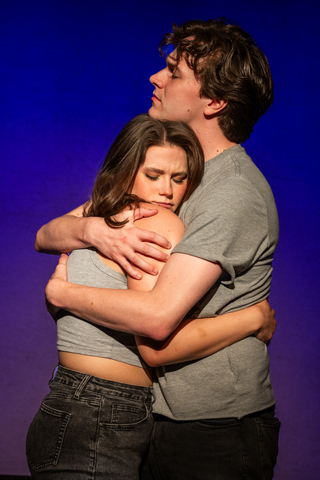It’s Not What It Looks Like
The play is a cleverly devised procedural drama that does justice to its title.

Chesney Mitchell and John Collins in “It Not What It Looks Like” at the SoHo Playhouse (Photo credit: Russ Rowland)
It is a dark and stormy night, and two people with blood on their clothing and hands stand in stark relief as lightning flashes and thunder crashes. A cell phone rings; it is a delivery person with an order from Chipotle. Do they take it or leave it? It is not such a consequential question amid a mounting storm of confusion, fear, and mystery, but it is a question that must be answered. And what about the blood?
It’s Not What It Looks Like, is a two-hander, written by John Collins in collaboration with Chesney Mitchell. It is the winner of the 2023 Soho Playhouse Lighthouse Series competition for new plays. The play is a cleverly devised procedural drama that does justice to its title: somebody died, but the how and why are unknown. It is a mystery with which to spend a summer evening.
Under Vincent DeGeorge’s skillful direction, the intricate shifts in time and place are woven without losing the thread of the mystery. The show explores the backstory of how the two main characters ended up with blood on their hands as the only witnesses to a gruesome death.
The show opens with a prologue that establishes that a bloody event has occurred. The nature of the event is unknown, but there are clues to what happened, not how it happened. The opening act has the two characters, listed as M (Collins) and W (Mitchell), in the harsh white light of an interrogation room. A projection screen forming the back wall of the performance area shows the word “Testimony.” The session is being taped, and their names are “bleeped” out, so they remain nameless.
The taped testimony is the framework around which the dramatic narrative is built. As they testify about the events that led up to their current situation, not only is the nature of their relationship revealed, but also the details of the significant events that shaped who they are and define how they process the world around them.
Collins’ portrayal of M shows an intelligent but troubled young man struggling to hold a job. His most recent was as a writer for a children’s television show, a job he lost because of his drinking and possible drug use. He is from North Dakota and moved to New York after his father died. He is living with his cousin W, solidly embodied by Mitchell, in her New York apartment. She is much more together psychologically than M, holding a secure job in social media management, with which she is unhappy.

Chesney Mitchell and John Collins in “It Not What It Looks Like” at the SoHo Playhouse (Photo credit: Russ Rowland)
The behavior of these two provides a portrait of two young people with emotional issues connected to their lives back in North Dakota: M regarding his father and W regarding her mother and, interestingly, also M’s father. W’s relationship with M’s father is a mystery that is revealed later in the play.
Collins and Mitchell do an excellent job transitioning from the taped testimony to interacting with the audience through the narration. The smooth flow solidly builds and deepens the complexity of the mystery. These two performers provide context to the various events being described by mimicking the voices of the various people they are describing and acting out some of these characters through dialogue and movement. They are effective in their portrayals of the not present but important characters.
The most consequential of these characters is Martino Pesci, who likes to be called Marty or Joe. M hears about him from someone at a club he and W are at one night. They believe he is a man with investments in North Dakota and may have known M’s dad. He develops a relationship with them as he takes them to expensive restaurants and sporting events. He offers to help M find a job and even gives him money. He offers to help W get a job in public relations through a friend of his. Everything seems fine with him when M and W wonder why this stranger has become so interested in their lives.
In trying to figure out who this man is, M and W begin to explore some of the things surrounding their life in North Dakota, including the death of M’s father. Elements of this exploration are methodically revealed to the audience through the testimony and narration without M’s and W’s understanding. It reveals important details about M and W related to M’s father. It is the trigger for the event that ends with the blood on their hands and clothes and the claim that “it isn’t what it looks like.”
Lighting design becomes essential when the set is a projection screen and two red metal chairs. Nicholas Pollock and Willem Hinternhoff deliver a lighting design that strongly supports Collins and Mitchell’s performances, with flashes of lightning, the glare of the interrogation, and the softness of an apartment, house, or club.
It’s Not What It Looks Like (through August 10, 2024)
SoHo Playhouse, 15 Vandam Street, in Manhattan
For tickets, call 212-691-1555, or visit https://ci.ovationtix.com/35583/production/1197973
Running time: 90 minutes without an intermission






Leave a comment